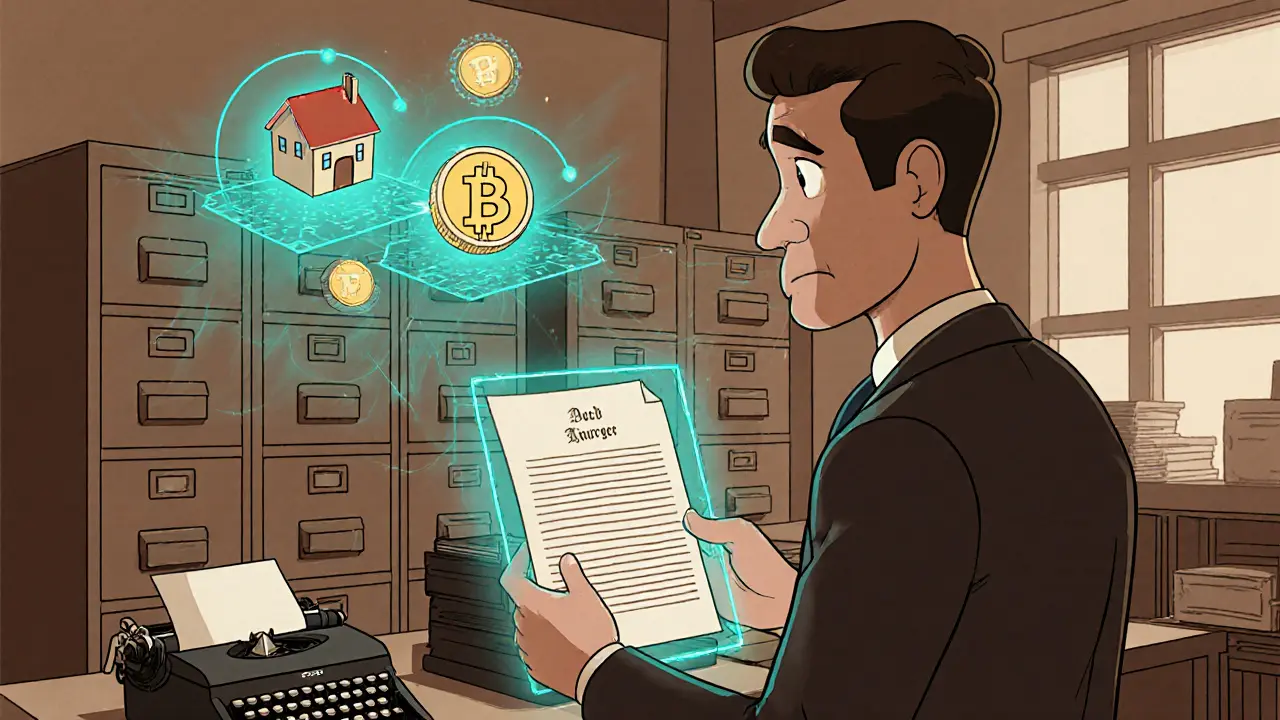Tokenized Real Estate Investment Calculator
Investment Analysis Tool
See how tokenized real estate compares to traditional ownership. Based on article examples: $100 token investment for 0.001% of Manhattan apartment.
Your Investment Breakdown
Tokenized Real Estate
Total value after 5 years
Traditional Real Estate
Total value after 5 years
Based on article examples: $100 investment in tokenized real estate with 4.5% annual yield, compared to traditional real estate with 0.5% transaction fees.
Key difference: Blockchain transactions cost $0.02-$0.15 vs. $15-$50 for traditional methods. This tool demonstrates the cumulative impact of lower fees.
For centuries, owning something meant paper deeds, notary seals, and weeks of paperwork. If you wanted to buy a share of a building, you needed thousands of dollars, a broker, and a lawyer. Today, you can own 0.001% of a Manhattan apartment for $100 - and it’s all recorded on a blockchain. This isn’t science fiction. It’s happening right now.
What Digital Asset Ownership Actually Means
Digital asset ownership isn’t just about owning Bitcoin or an NFT. It’s about proving you own something - a house, a piece of art, a share in a fund - using cryptography and code, not banks or government registries. The key shift? Your ownership is stored on a public, unchangeable ledger. No middleman can erase it. No bureaucrat can delay it. If you hold the private key, you hold the asset. This isn’t theoretical. In 2025, over 86% of institutional investors either own digital assets or plan to in the next year. And it’s not just crypto speculators. Hedge funds, pension plans, and real estate firms are moving billions into tokenized real estate, private equity, and even music royalties - all broken into tiny, tradable pieces.Why Blockchain Changes Everything
Traditional ownership relies on layers of intermediaries: custodians, transfer agents, clearinghouses. Each adds cost, delay, and risk. Settlement for a stock trade? Two to three business days. For a tokenized asset? Twelve to thirty seconds. Transaction fees tell the story too. Selling a $10,000 bond through traditional channels? You’ll pay $15 to $50 in fees. On Ethereum or Polygon? $0.02 to $0.15. That’s not a tweak - it’s a revolution. Smart contracts automate what used to take teams of lawyers. Want to split rental income from a property among 100 owners? A smart contract does it automatically, every month, without a single human touch. Want to restrict resale to accredited investors only? The code enforces it. No loopholes. No exceptions.Tokenized Real Estate Is Leading the Charge
The fastest-growing slice of digital asset ownership isn’t Bitcoin. It’s real-world assets - RWAs - like property, infrastructure, and private equity. By 2030, Boston Consulting Group predicts this market will hit $16 trillion. That’s three times the projected value of all cryptocurrencies combined. Take the Real Estate Metaverse (REM) platform. You don’t need $50,000 to invest in a commercial building anymore. You can buy a $100 slice. You get proportional rent. You can sell it anytime. No waiting for a buyer. No listing fees. No open houses. The blockchain handles it all. BlackRock is planning to launch tokenized private equity funds in early 2026 with minimum investments of $1,000. Compare that to the traditional $250,000 minimum. This isn’t just convenience - it’s democratizing access to wealth-building tools that used to be locked behind wealth.
Who’s Driving This Change?
Institutional investors are leading. Private equity firms (92%) and hedge funds (89%) have jumped in hardest. Pension funds are slower, at 67%, but catching up fast. Why? Because they see the numbers: reduced settlement risk, lower operational costs, new revenue streams. But they’re not doing it alone. Tech giants like Google and Amazon are entering the space, offering custody and infrastructure. Specialized firms like Fireblocks and Anchorage handle the heavy lifting of secure storage. Even JPMorgan and BlackRock now run their own blockchain-based asset platforms. The market is split: 41% controlled by traditional finance players, 33% by blockchain-native firms, and 12% by tech companies. It’s not a battle - it’s a merger. The old world is learning the new language.The Tech Behind the Trust
Ethereum still dominates, handling 56.3% of all tokenized asset transactions. But Solana and Polygon are gaining ground, especially for faster, cheaper trades. Why? Because not every asset needs the security of Ethereum. A $500 art token doesn’t need the same safeguards as a $50 million bond. Custody has evolved too. Sixty-three percent of institutions now use multi-party computation (MPC) - a system where no single person holds the full key. It’s like having three locks on a safe, and you need two people to open it. Combine that with cold storage (used by 76% of institutions) and insurance policies averaging $250 million per custodian, and the security gap is closing fast. And now, ERC-6551 tokens are letting NFTs act like smart wallets. Your NFT isn’t just a picture - it can hold other assets, manage permissions, and even execute trades. That’s a giant leap from digital collectibles to functional ownership tools.The Big Roadblocks
It’s not all smooth sailing. Regulatory confusion is the #1 concern for 78% of institutional investors. The U.S. has no unified rulebook. The EU’s MiCA regulations took effect in January 2025, but the U.S. is still playing catch-up. China bans it. India taxes it at 30%. One country’s innovation is another’s crime. Cross-chain interoperability is another headache. You can’t move a token from Ethereum to Solana without bridges - and bridges have been hacked for billions. Solutions are coming, but they’re not ready for prime time. Then there’s the human factor. Tax reporting for digital assets is 300% more complex than for stocks. Custody providers vary wildly in quality. One platform might charge $1 million minimum. Another might freeze your assets for 72 hours if you trigger a security alert. And let’s not forget the lessons of FTX. Without standardized custody rules, one bad actor can still bring down trust. Professor Gary Markus of NYU Stern warned that digital asset ownership could create systemic risks during market stress - exactly what happened in 2022.

1 Comments
so basically we're trading paper ghosts for digital ghosts... but now the ghosts can be hacked, frozen, or taxed by some algorithm in a server farm in Iceland. i'm not saying it's bad, i'm just saying we're building a house of cards out of cryptographic glitter and calling it progress.